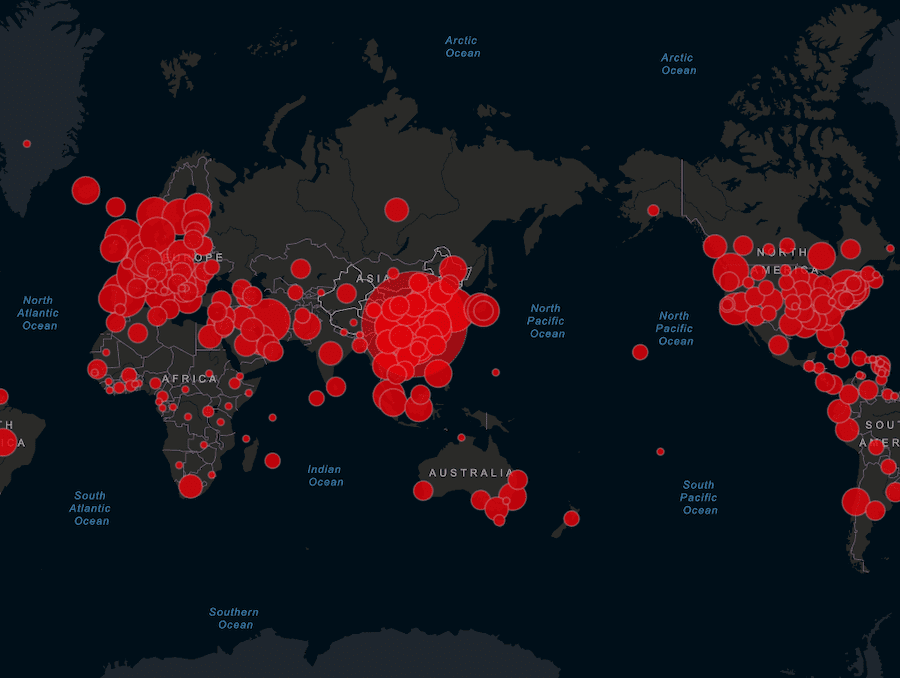WEDNESDAY, MARCH 18 2020 AS OF 6:00 PM EST
Despite global efforts to control the spread of the novel coronavirus (COVID19), the number of confirmed cases continues to rise. To-date, there are roughly 214,800 confirmed cases worldwide and approximately 8,700 fatalities. Confirmed cases in the United States (US) have climbed to more than 7,700. International and national restrictions, bans, and requirements of focused actions to mitigate spread of COVID-19 have greatly affected the economy. With uncertainty around the trajectory of COVID-19, many communities, businesses, and individuals are thinking about long-term economic impacts and how to stay financially resilient.
Johns Hopkins 2019-nCoV Map of Global Cases: Source
Reports estimate that the international, cumulative economic loss in output could reach $2.7 trillion. In the first quarter of 2020, Gross Domestic Product (GDP) has slowed to 1.2 percent year-on-year. As the pandemic grows, GDP is estimated to drop as much as 3 percent across all nations, with some nations experiencing a 4.8 percent drop. There is still a high level of uncertainty into total economic losses. For example, when this virus was largely contained within China, the International Air Transport Association (IATA) estimated their total loss at approximately $29.3 billion. As of March 5, IATA estimates those losses are now between $63 and $113 billion.
Economic instability is a growing concern in the US. While the country continues to respond to the spread of COVID-19, supply chains are greatly disrupted which could have long-term economic impacts. Joshua Epstien, Professor of Epidemiology at the New York University (NYU) School of Global Public Health, estimates, “A one-month closure of all US schools and daycare centers could cost the US economy upwards of $50 billion in lost productivity due to absenteeism, which would represent 0.2% (two-tenths of a percent) of GDP.” Further, a severe COVID-19 outbreak could cost $90 billion in medical expenses for the US.
IATA on Economic Recovery For Airlines: Source
The industry crisis caused by #COVID19 pandemic will be worse than 9/11. #Airlines are struggling for survival.
As air transport will be critical for economic recovery, govts need to step in to maintain vital transport links. Here are some relief measures that will help ? pic.twitter.com/by2HRODqSg
— IATA (@IATA) March 18, 2020
To help Americans combat the economic impact of COVID-19, the Trump Administration is currently working with the Congress to approve and send immediate cash payments directly to Americans, among other relief mechanisms.
KEY COST RECOVERY FUNDING SOURCES
On Friday, the President declared a national emergency under the Stafford Act. This authorizes the Federal Emergency Management Agency (FEMA) to utilize over $42 billion of disaster relief funding to support state, local, tribal, and territorial (SLTT) governments, and certain private nonprofits (PNPs), specifically including hospitals, universities, and schools, in response to COVID-19.
Most notably, this Emergency Declaration allows FEMA Public Assistance (PA) Program Category B funding to be used for certain emergency protective measures that do not duplicate the US Department of Health and Human Services (HHS) assistance and direct federal assistance (DFA) by which FEMA can ‘mission assign’ other federal agencies to support response efforts.
In addition to FEMA PA Program support, the following additional funding sources are being made available:
- The Federal Transit Authority (FTA) Emergency Relief Program has made certain activities eligible for transportation response measures related to COVID-19. These activities include emergency protective measures to eliminate or lessen threats to public health and safety, such as performing enhanced cleaning and placing hand sanitizer dispensers in high traffic areas and providing personal protective equipment as appropriate, etc.
- The US Department of Housing and Urban Development (HUD) announced that Grantees can repurpose Community Disaster Block Grant (CDBG) funding to cover health care and other services in response to COVID-19.
- Further, the Families First Coronavirus Response Act, which was just passed by the Senate this afternoon, will include tens of billions of dollars for sick leave, unemployment insurance, Special Supplemental Nutrition Program for Women, Infants, and Children (WIC), and other measures in response to the cascading COVID-19 impact.
Cash Flow: Source
CRITICAL STEPS TO MAXIMIZE COST RECOVERY OUTCOMES
- Step 1: Complete statutory procedures to request a Major Disaster Declaration. This has been strongly encouraged by the President and, if/when a Presidential Major Disaster Declaration occurs, it is another tool in providing funding to those impacted by COVID-19.
- Step 2: Request Public Assistance. Applicants requesting FEMA PA grant funding are required to submit a formal Request for Public Assistance (RPA), through the Recipient, to FEMA within 30 days of the emergency declaration date. For the national emergency declaration in response to COVID-19, the RPA 30-day deadline ends on April 5.
- Step 3: Track incurred costs. In an effort to help you proactively navigate these programs and maximize potential reimbursement, it is critical to track all potentially eligible costs incurred. For a list of sample cost documentation to track and collect, see FEMA’s PA Program and Policy Guide (PAPPG), “Documentation to Support Cost Claims.”
These funding programs provide the opportunity to better prepare for, respond to, and recover from the ongoing COVID-19 crisis. However, these programs are complex and often lack clarity, especially in unprecedented events such as this. Proactive, strategic, and expert management of eligible activities, costs, and documentation requirements will promote successful short-term response and long-term financial recovery. Additionally, FEMA provides funding to manage the administration and execution of these grants, which may be used to hire disaster recovery consultant experts to augment and supplement your staff.
STAY UPDATED AND LEARN MORE HERE:
- John Hopkins University’s Coronavirus COVID-19 Global Cases Map
- 2019 Novel Coronavirus Situation Updates by CDC
- World Health Organization Coronavirus Information
- Hagerty Consulting Quarantine and Isolation Workshops
Keep track of Hagerty’s Incident coverage here:


